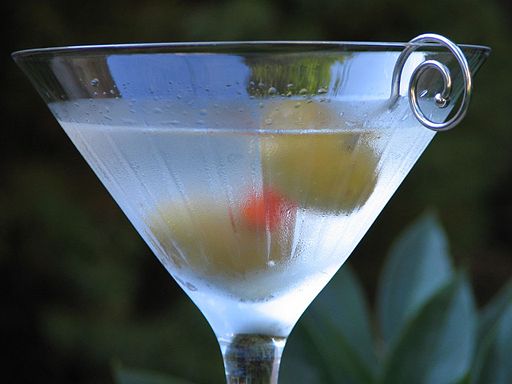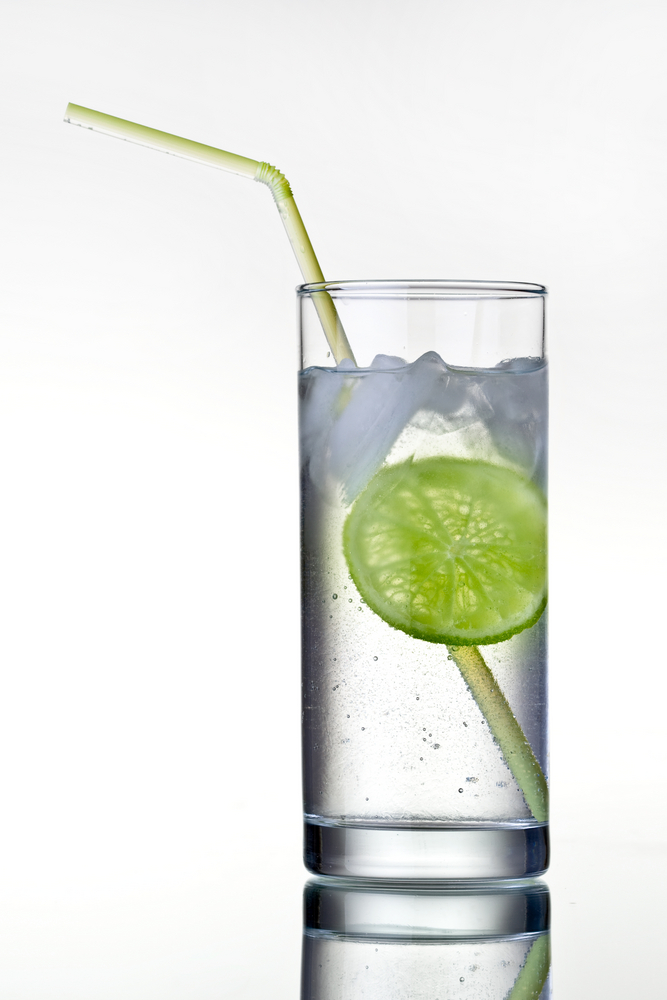It wouldn’t be right to kick off our new “Drink of the Week” feature with any less of a beverage than this most durable but paradoxically most intimidating of cocktails. It’s the strong but perfect before dinner drink.
A million things have been written about martinis, but the first thing you need to realize is that it’s a specific cocktail and not just any liquid poured into a martini glass. We love a good chocolate martini, because it’s chocolate, but it’s no more a martini than a chocolate bunny is a rabbit. A cosmopolitan is also not a martini; it’s a freaking cosmopolitan.
Here’s our starter recipe:
2 ounces gin or vodka
1 ounce vermouth
1-2 dashes of Regan’s Orange Bitters (optional, but especially recommended with gin)
Olive(s) or twist of lemon garnish
 Pour gin/vodka and vermouth over ice into cocktail shaker, along with a dash or two of orange bitters if you’ve got them. Shake or stir very vigorously and strain into chilled martini glass or, for smaller portions, a wide-mouthed champagne glass, add olive(s) or lemon twist. Always serve up — i.e., without ice. (We know people who drink martinis on the rocks, but we’ve tried them that way and think they’re wrong. Very, very wrong.)
Pour gin/vodka and vermouth over ice into cocktail shaker, along with a dash or two of orange bitters if you’ve got them. Shake or stir very vigorously and strain into chilled martini glass or, for smaller portions, a wide-mouthed champagne glass, add olive(s) or lemon twist. Always serve up — i.e., without ice. (We know people who drink martinis on the rocks, but we’ve tried them that way and think they’re wrong. Very, very wrong.)
Now, note that this is a starter recipe. You’ve doubtless heard of the dry martini. It’s possible that the term once simply referred to dry vermouth, but in common usage this is one with very little vermouth. From the “M.A.S.H.” TV series, to “Auntie Mame,” to Luis Buñuel’s surrealist comedy classic, “The Discrete Charm of the Bourgeoisie,” the extremely dry martini has been lionized and joked about endlessly in low, middle, and high culture. Feel free to experiment in the direction of less vermouth, reducing the amount as much as you dare.
It’s even legitimate to make your martini a la Mame Dennis (Rosalind Russell, in the movie) and pour a small amount of vermouth into a glass and then simply discard it, filling it with extremely cold strained gin or vodka afterward. This can work particularly well with vodka. We’re pretty sure, however, that Luis Buñuel was kidding in his autobiography when he suggested merely having a ray of sunlight pass through a vermouth bottle on its way to a gin bottle.
Importantly, don’t be afraid to go in the opposite, not-so-dry, direction. Many would call our recipe, which is in fact similar to what you’ll find on the back of vermouth bottles, a bit overly “wet,” particularly for vodka. Nevertheless, it’s good to use a significant amount of a good brand of vermouth. (Señor Buñuel’s choice of Noilly-Pratt is our default.) The martini is, after all, a cocktail not just a gussied up shot. We’ve even been experimenting with a drink called, “the fitty-fitty” which is, as you would expect, 50 percent gin and 50 percent vermouth. Done right, it’s an extremely smooth martini and highly recommended.
Moving on, our take on the shaken vs. stirred debate is that shaking works really well for vodka martinis, which is what James Bond is mostly ordering in the movies, and we’re still making our mind up about how it works with gin. We’ve had good and less good gin martinis made both ways.
We hope to return to the shaken/stirred and dry/not dry dichotomies at some date in the not-so-immediate future as we continue to explore classic cocktails. For now, just remember that martinis are very much a case of trial and error with your taste buds, but even the errors should be fun.



 So, this all started when, through the kindness of a smart and generous publicist working for Diageo, two bottles of very good vodka found their way to my door. Ketel One is the solid and very popular brand of premium liquor you probably all know, with its bright, clean taste. With a bit more complexity and bite than we usually associate with what was once marketed as “white whisky,” certified organic Moon Mountain Vodka, a small batch liquor, also came my way. Both are superior vodkas which, I’m certain, would do very well in any good vodka cocktail from a
So, this all started when, through the kindness of a smart and generous publicist working for Diageo, two bottles of very good vodka found their way to my door. Ketel One is the solid and very popular brand of premium liquor you probably all know, with its bright, clean taste. With a bit more complexity and bite than we usually associate with what was once marketed as “white whisky,” certified organic Moon Mountain Vodka, a small batch liquor, also came my way. Both are superior vodkas which, I’m certain, would do very well in any good vodka cocktail from a  Of all the boozy discoveries I’ve made in the relatively short time I’ve been writing DOTW, easily the most personally fascinating to me is Campari and the great cocktail made with it,
Of all the boozy discoveries I’ve made in the relatively short time I’ve been writing DOTW, easily the most personally fascinating to me is Campari and the great cocktail made with it,  Highballs are not any one particular drink but any cocktail comprised of an alcoholic base and a much larger proportion of some non-alcoholic beverage. Ordinarily, we wouldn’t bother with a lot of highballs because there’s not much point in giving you a recipe for, say, rum and coke or a 7 and 7 (just in case you’re extremely new to booze, that’s 7-Up and Seagram’s 7 whiskey). Your basic highball is 1-2 ounces of booze, a mixer to taste — about five or six ounces, maybe, and some ice. You can throw in a garnish of your preference, like a lime or lemon wedge, if you want to get fancy.
Highballs are not any one particular drink but any cocktail comprised of an alcoholic base and a much larger proportion of some non-alcoholic beverage. Ordinarily, we wouldn’t bother with a lot of highballs because there’s not much point in giving you a recipe for, say, rum and coke or a 7 and 7 (just in case you’re extremely new to booze, that’s 7-Up and Seagram’s 7 whiskey). Your basic highball is 1-2 ounces of booze, a mixer to taste — about five or six ounces, maybe, and some ice. You can throw in a garnish of your preference, like a lime or lemon wedge, if you want to get fancy. Pour gin/vodka and vermouth over ice into cocktail shaker, along with a dash or two of orange bitters if you’ve got them. Shake or stir very vigorously and strain into chilled martini glass or, for smaller portions, a wide-mouthed champagne glass, add olive(s) or lemon twist. Always serve up — i.e., without ice. (We know people who drink martinis on the rocks, but we’ve tried them that way and think they’re wrong. Very, very wrong.)
Pour gin/vodka and vermouth over ice into cocktail shaker, along with a dash or two of orange bitters if you’ve got them. Shake or stir very vigorously and strain into chilled martini glass or, for smaller portions, a wide-mouthed champagne glass, add olive(s) or lemon twist. Always serve up — i.e., without ice. (We know people who drink martinis on the rocks, but we’ve tried them that way and think they’re wrong. Very, very wrong.)








